Benjamin Smith
Benjamin Smith II, London silversmith. Originally of Birmingham, born 15 December 1764, first marriage 1788. Grimwade records first mention of Benjamin Smith through a 3rd party recommendation as ‘an Ingeneous Chaser’ in 1790 to Matthew Boulton at Birmingham. By September 1792 the firm of Boulton and Smith, latchet manufacturers was in existence.
In 1801 Benjamin withdrew from the partnership and went to London. On 1 February 1802, Benjamin married for a second time to Mary Shiers at Greenwich Church and was presumably setting up the workshop there. First mark, in partnership with Digby Scott, 4 October 1802. Second mark together, 21 March 1803. The partnership apparently dissolved by 11 May 1807, when Smith entered a third separate mark. Fourth mark, 25 June 1807. Fifth mark in partnership with his brother James 1809. Sixth separate mark, 1812. Seventh mark, 1814. Eighth mark in partnership with his son Benjamin, 1816. Ninth mark alone again, 1818.
By his first marriage Smith had four sons, of whom Benjamin was the eldest and three daughters, and by Mary Shiers a fourth daughter in 1803 at Greenwich. His third son Digby, born 2 June 1797, may be assumed to be the godson of Digby Scott.
It appears that Smith was of a difficult and probably irascible nature and is this borne out by the variations in his entry of marks with and without partners. His firm was of course, together with Storr, manufacturing almost entirely for Rundell and Bridge, and it seems that the later may have supported Smith’s move to London. The firm’s most important production is probably The Jamaica Service of 1803 in The Royal Collection. The silver-gilt trays, baskets, and wine coasters with open-work vine borders are among the most distinctive and accomplished achievements. The designs, so closely related to those of Storr, most almost certainly stemmed from central control by Rundell and Bridge.
Benjamin Smith III, eldest son of Benjamin Smith II, apprenticed to his father 1808, free 1821. 1st mark with his father 1816. 2nd mark alone. 3rd mark, 2 sizes, 1822. 4th mark, 2 sizes, 1837. Livery 1842. Died 1850.
Benjamin Smith
Benjamin Smith II, London silversmith. Originally of Birmingham, born 15 December 1764, first marriage 1788. Grimwade records first mention of Benjamin Smith through a 3rd party recommendation as ‘an Ingeneous Chaser’ in 1790 to Matthew Boulton at Birmingham. By September 1792 the firm of Boulton and Smith, latchet manufacturers was in existence.
In 1801 Benjamin withdrew from the partnership and went to London. On 1 February 1802, Benjamin married for a second time to Mary Shiers at Greenwich Church and was presumably setting up the workshop there. First mark, in partnership with Digby Scott, 4 October 1802. Second mark together, 21 March 1803. The partnership apparently dissolved by 11 May 1807, when Smith entered a third separate mark. Fourth mark, 25 June 1807. Fifth mark in partnership with his brother James 1809. Sixth separate mark, 1812. Seventh mark, 1814. Eighth mark in partnership with his son Benjamin, 1816. Ninth mark alone again, 1818.
By his first marriage Smith had four sons, of whom Benjamin was the eldest and three daughters, and by Mary Shiers a fourth daughter in 1803 at Greenwich. His third son Digby, born 2 June 1797, may be assumed to be the godson of Digby Scott.
It appears that Smith was of a difficult and probably irascible nature and is this borne out by the variations in his entry of marks with and without partners. His firm was of course, together with Storr, manufacturing almost entirely for Rundell and Bridge, and it seems that the later may have supported Smith’s move to London. The firm’s most important production is probably The Jamaica Service of 1803 in The Royal Collection. The silver-gilt trays, baskets, and wine coasters with open-work vine borders are among the most distinctive and accomplished achievements. The designs, so closely related to those of Storr, most almost certainly stemmed from central control by Rundell and Bridge.
Benjamin Smith III, eldest son of Benjamin Smith II, apprenticed to his father 1808, free 1821. 1st mark with his father 1816. 2nd mark alone. 3rd mark, 2 sizes, 1822. 4th mark, 2 sizes, 1837. Livery 1842. Died 1850.
-

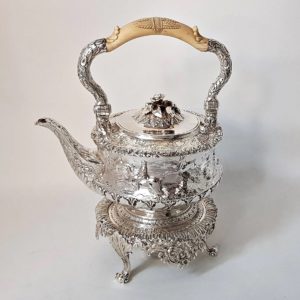
1825
Benjamin Smith
9823 Georgian Silver Tea Kettle
£6,850
Of sporting interest. A magnificent antique sterling silver tea kettle (also known as a samovar or hot water kettle) with a scene of horses hunting to hounds. The kettle is all over decorated with flowers, foliage, scrolls and cast borders. It has a pretty flower lid finial and folding ivory handle. The matching silver tea kettle stand has an ornate cast and pierced frieze with flowers and leaves; the integral burner has a detachable cap to insert the oil and wick. An excellent piece with heavy gauge silver and good colour. Hand engraved to the top of the burner is a stag crest. Contains 1400 ml. Total weight 1945 grams, 62.5 troy ounces. Total height 31.5cm (to top of handle), 23cm (to top of kettle). London 1825. Makers Benjamin Smith and Richard Sibley.
-

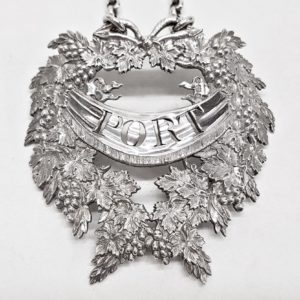
1808
Benjamin Smith
9331 George III Silver Wine Label
Sold
A large and fine antique silver bottle ticket with deep relief grape vine decoration. Across the centre there is a banner with the pierced title “PORT”. Weight 64 grams, 2 troy ounces. Height 7.5 cm. Width 8 cm. London 1808. Maker Benjamin Smith. Makes a pair with #9330
-

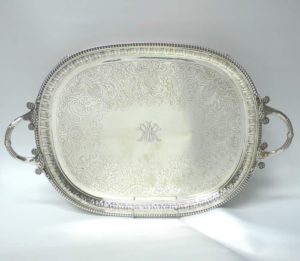
1816
Benjamin Smith
7151 Georgian Silver Tray by Benjamin Smith
Sold
An excellent antique sterling silver tray by this prestigious maker. With flower decorated carrying handles and winged feet. The hand engraved centre is particularly attractive with flowers and scrolls. There is an intertwined engraved monogram to the centre. Good weight 3044 grams, 97.8 troy ounces. Spread 59 cms. Length 47 cms. Width 38 cms. London 1816. Maker Benjamin Smith.
-

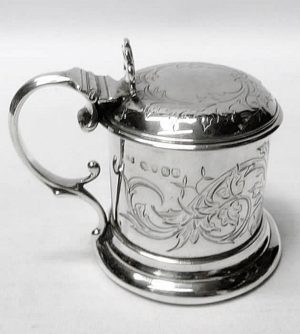
1849
Benjamin Smith
7613 Antique Silver Mustard Pot
Sold
An excellent sterling silver mustard pot of circular form with a hinged lid by the highly regarded Benjamin Smith. The body and lid with a pretty hand engraved decoration with flowers and scrolls, the front with a crest of a stag encircled by a snake. Original blue glass liner. Weight 153 grams, 4.9 troy ounces. Height 8.5cm. Diameter of base 7.5cm. London 1849. Maker Benjamin Smith.
-

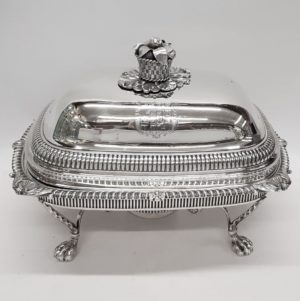
1808
Benjamin Smith
9436 George III Silver Entrée Dish on Stand
Sold
A superb antique sterling silver serving dish with matching cover and warming base. Amazing basket of flowers design handle. The elegant plain styling has a broad band of ribbing with gadroon and shell borders. Excellent quality and good gauge silver. The lid has a large hand engraved armorial to the front and a double crest to the reverse. Silver weight 3350 grams, 107 troy ounces. Total height 24cm. Dish measures 33x24cm. London 1808. Maker Benjamin Smith.
-

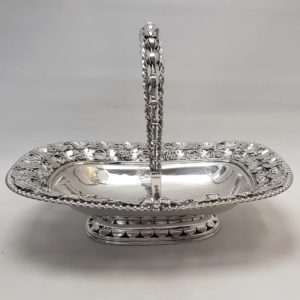
1807
Benjamin Smith
10137 George III Antique Silver Basket
Sold
A very fine antique silver basket of rectangular form with swing handle and pierced silver foot. Excellent quality and weight as you’d expect from this highly desirable maker. The openwork vine borders are among the most distinctive and accomplished achievements of Benjamin Smith and similar to those of Paul Storr, not surprisingly as both firms manufactured almost entirely for Rundell and Bridge at this time. The centre has an engraved “C” within an applied cartouche with swags and bells. Weight 1322 grams, 42.5 troy ounces. Height 21.5cm (handle extended), 7.2cm (handle folded). Length 30cm. Width 24.5cm. London 1807. Maker Benjamin Smith.